2016 NISSAN ALTIMA towing
[x] Cancel search: towingPage 446 of 491
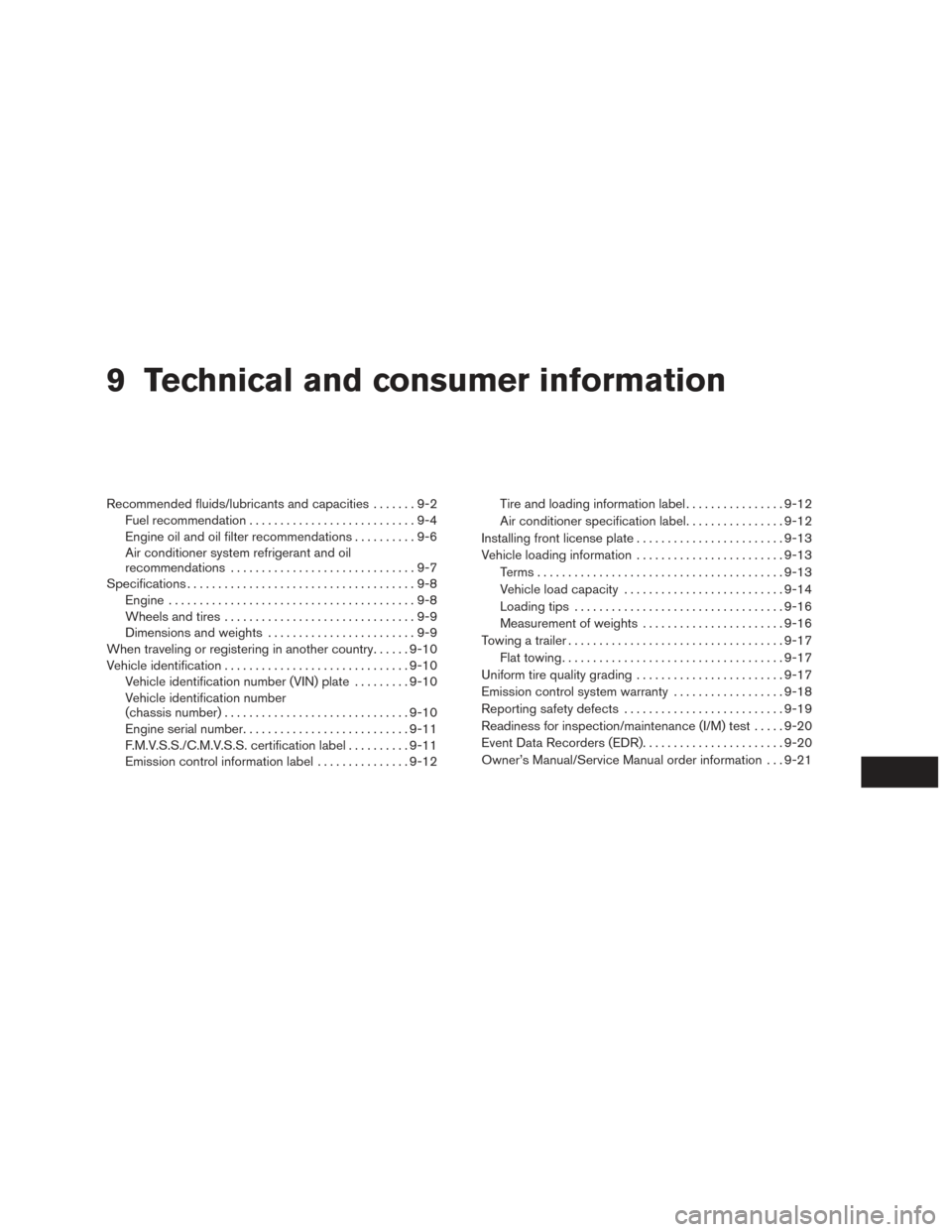
9 Technical and consumer information
Recommended fluids/lubricants and capacities.......9-2
Fuel recommendation ...........................9-4
Engine oil and oil filter recommendations ..........9-6
Air conditioner system refrigerant and oil
recommendations ..............................9-7
Specifications .....................................9-8
Engine ........................................9-8
Wheels and tires ...............................9-9
Dimensions and weights ........................9-9
When traveling or registering in another country ......9-10
Vehicle identification .............................. 9-10
Vehicle identification number (VIN) plate .........9-10
Vehicle identification number
(chassis number) .............................. 9-10
Engine serial number ........................... 9-11
F.M.V.S.S./C.M.V.S.S. certification label ..........9-11
Emission control information label ...............9-12Tire and loading information label
................9-12
Air conditioner specification label ................9-12
Installing front license plate ........................9-13
Vehicle loading information ........................9-13
Terms ........................................ 9-13
Vehicle load capacity .......................... 9-14
Loading tips .................................. 9-16
Measurement of weights .......................9-16
Towing a trailer ................................... 9-17
Flat towing .................................... 9-17
Uniform tire quality grading ........................9-17
Emission control system warranty ..................9-18
Reporting safety defects .......................... 9-19
Readiness for inspection/maintenance (I/M) test .....9-20
Event Data Recorders (EDR) .......................9-20
Owner’s Manual/Service Manual order information . . . 9-21
Page 452 of 491
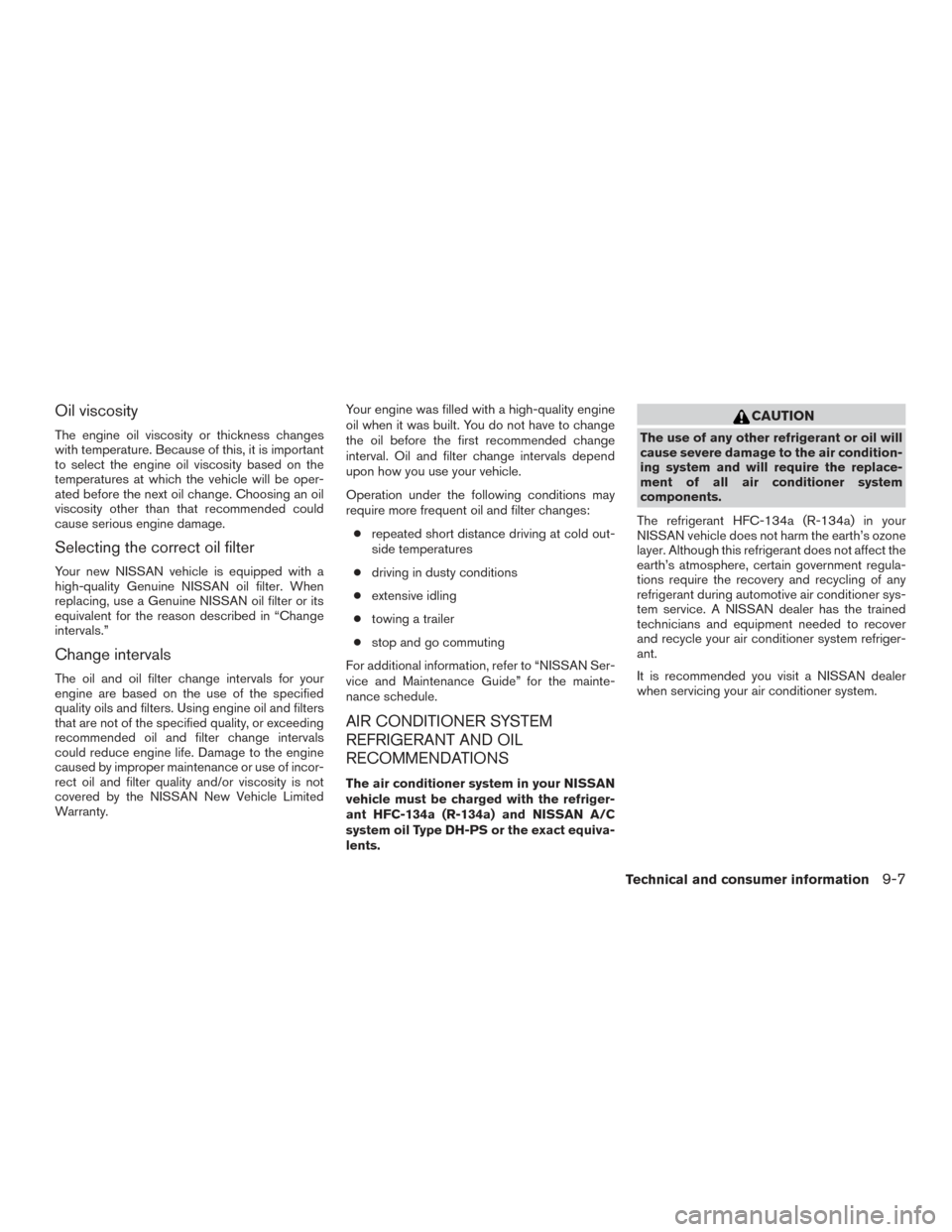
Oil viscosity
The engine oil viscosity or thickness changes
with temperature. Because of this, it is important
to select the engine oil viscosity based on the
temperatures at which the vehicle will be oper-
ated before the next oil change. Choosing an oil
viscosity other than that recommended could
cause serious engine damage.
Selecting the correct oil filter
Your new NISSAN vehicle is equipped with a
high-quality Genuine NISSAN oil filter. When
replacing, use a Genuine NISSAN oil filter or its
equivalent for the reason described in “Change
intervals.”
Change intervals
The oil and oil filter change intervals for your
engine are based on the use of the specified
quality oils and filters. Using engine oil and filters
that are not of the specified quality, or exceeding
recommended oil and filter change intervals
could reduce engine life. Damage to the engine
caused by improper maintenance or use of incor-
rect oil and filter quality and/or viscosity is not
covered by the NISSAN New Vehicle Limited
Warranty.Your engine was filled with a high-quality engine
oil when it was built. You do not have to change
the oil before the first recommended change
interval. Oil and filter change intervals depend
upon how you use your vehicle.
Operation under the following conditions may
require more frequent oil and filter changes:
● repeated short distance driving at cold out-
side temperatures
● driving in dusty conditions
● extensive idling
● towing a trailer
● stop and go commuting
For additional information, refer to “NISSAN Ser-
vice and Maintenance Guide” for the mainte-
nance schedule.
AIR CONDITIONER SYSTEM
REFRIGERANT AND OIL
RECOMMENDATIONS
The air conditioner system in your NISSAN
vehicle must be charged with the refriger-
ant HFC-134a (R-134a) and NISSAN A/C
system oil Type DH-PS or the exact equiva-
lents.
CAUTION
The use of any other refrigerant or oil will
cause severe damage to the air condition-
ing system and will require the replace-
ment of all air conditioner system
components.
The refrigerant HFC-134a (R-134a) in your
NISSAN vehicle does not harm the earth’s ozone
layer. Although this refrigerant does not affect the
earth’s atmosphere, certain government regula-
tions require the recovery and recycling of any
refrigerant during automotive air conditioner sys-
tem service. A NISSAN dealer has the trained
technicians and equipment needed to recover
and recycle your air conditioner system refriger-
ant.
It is recommended you visit a NISSAN dealer
when servicing your air conditioner system.
Technical and consumer information9-7
Page 462 of 491
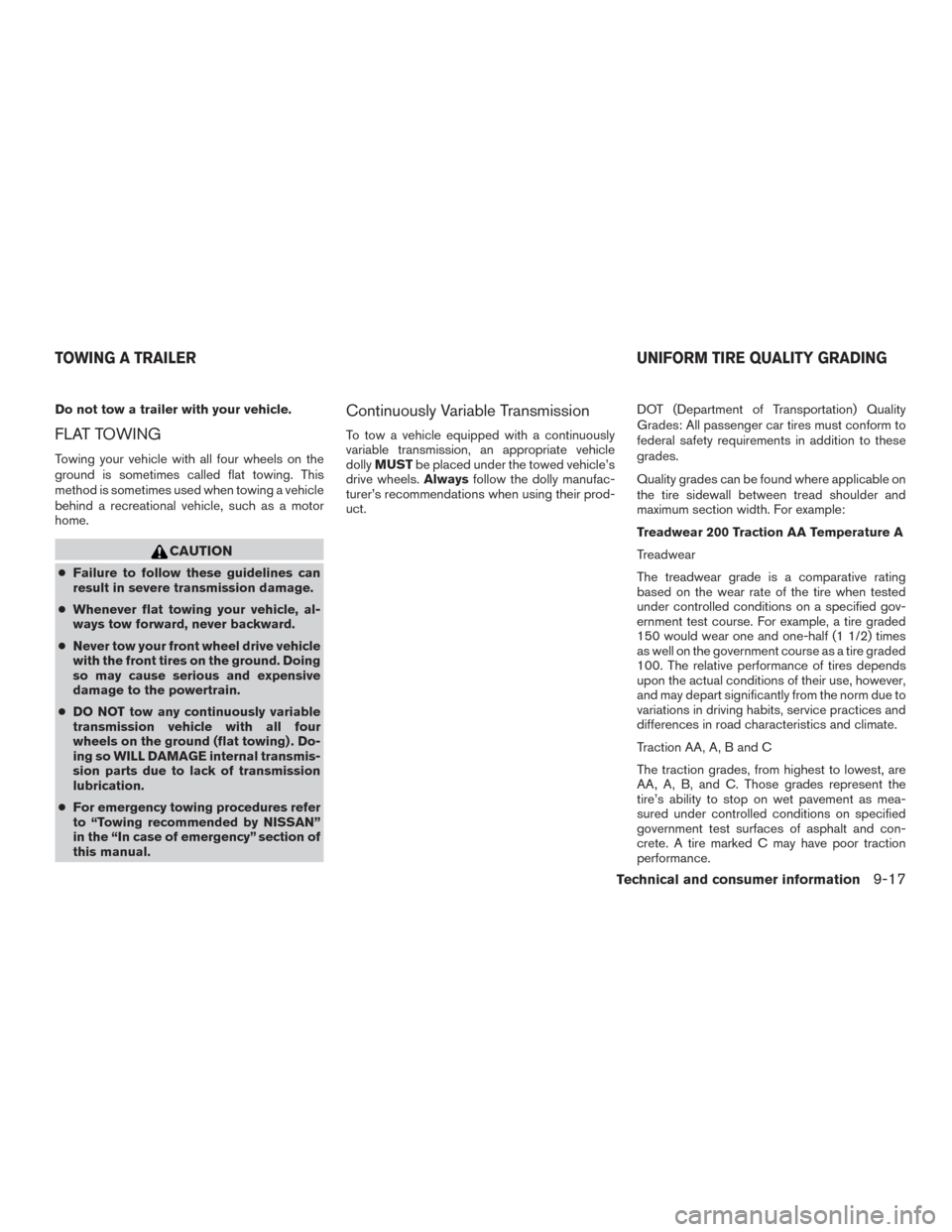
Do not tow a trailer with your vehicle.
FLAT TOWING
Towing your vehicle with all four wheels on the
ground is sometimes called flat towing. This
method is sometimes used when towing a vehicle
behind a recreational vehicle, such as a motor
home.
CAUTION
●Failure to follow these guidelines can
result in severe transmission damage.
● Whenever flat towing your vehicle, al-
ways tow forward, never backward.
● Never tow your front wheel drive vehicle
with the front tires on the ground. Doing
so may cause serious and expensive
damage to the powertrain.
● DO NOT tow any continuously variable
transmission vehicle with all four
wheels on the ground (flat towing) . Do-
ing so WILL DAMAGE internal transmis-
sion parts due to lack of transmission
lubrication.
● For emergency towing procedures refer
to “Towing recommended by NISSAN”
in the “In case of emergency” section of
this manual.
Continuously Variable Transmission
To tow a vehicle equipped with a continuously
variable transmission, an appropriate vehicle
dolly MUST be placed under the towed vehicle’s
drive wheels. Alwaysfollow the dolly manufac-
turer’s recommendations when using their prod-
uct. DOT (Department of Transportation) Quality
Grades: All passenger car tires must conform to
federal safety requirements in addition to these
grades.
Quality grades can be found where applicable on
the tire sidewall between tread shoulder and
maximum section width. For example:
Treadwear 200 Traction AA Temperature A
Treadwear
The treadwear grade is a comparative rating
based on the wear rate of the tire when tested
under controlled conditions on a specified gov-
ernment test course. For example, a tire graded
150 would wear one and one-half (1 1/2) times
as well on the government course as a tire graded
100. The relative performance of tires depends
upon the actual conditions of their use, however,
and may depart significantly from the norm due to
variations in driving habits, service practices and
differences in road characteristics and climate.
Traction AA, A, B and C
The traction grades, from highest to lowest, are
AA, A, B, and C. Those grades represent the
tire’s ability to stop on wet pavement as mea-
sured under controlled conditions on specified
government test surfaces of asphalt and con-
crete. A tire marked C may have poor traction
performance.
TOWING A TRAILER
UNIFORM TIRE QUALITY GRADING
Technical and consumer information9-17
Page 473 of 491
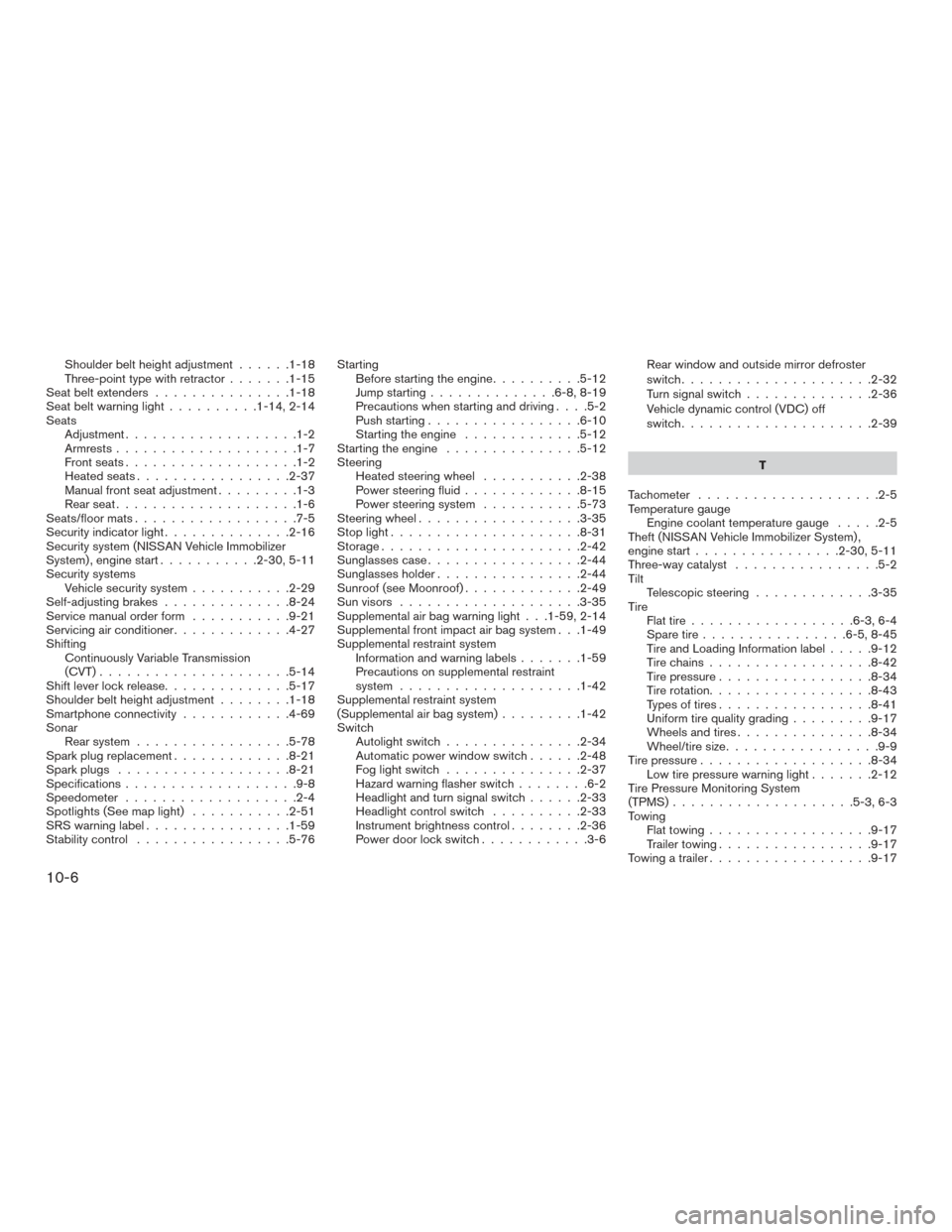
Shoulder belt height adjustment......1-18
Three-point type with retractor .......1-15
Seat belt extenders ...............1-18
Seatbeltwarninglight..........1-14,2-14
Seats Adjustment ...................1-2
Armrests....................1-7
Frontseats...................1-2
Heatedseats.................2-37
Manual front seat adjustment .........1-3
Rear seat ....................1-6
Seats/floor mats ..................7-5
Security indicator light ..............2-16
Security system (NISSAN Vehicle Immobilizer
System) , engine start ...........2-30,5-11
Security systems Vehicle security system ...........2-29
Self-adjusting brakes ..............8-24
Service manual order form ...........9-21
Servicing air conditioner .............4-27
Shifting Continuously Variable Transmission
(CVT) .....................5-14
Shift lever lock release..............5-17
Shoulder belt height adjustment ........1-18
Smartphone connectivity ............4-69
Sonar Rear system .................5-78
Spark plug replacement .............8-21
Spark plugs ...................8-21
Specifications ...................9-8
Speedometer ...................2-4
Spotlights(Seemaplight) ...........2-51
SRS warning label ................1-59
Stability control .................5-76 Starting
Before starting the engine ..........5-12
Jump starting ..............6-8,8-19
Precautions when starting and driving ....5-2
Push starting .................6-10
Starting the engine .............5-12
Starting the engine ...............5-12
Steering Heated steering wheel ...........2-38
Power steering fluid .............8-15
Power steering system ...........5-73
Steeringwheel..................3-35
Stoplight.....................8-31
Storage......................2-42
Sunglassescase.................2-44
Sunglassesholder................2-44
Sunroof(seeMoonroof).............2-49
Sun visors ....................3-35
Supplemental air bag warning light . . .1-59, 2-14
Supplemental front impact air bag system . . .1-49
Supplemental restraint system Information and warning labels .......1-59
Precautions on supplemental restraint
system ....................1-42
Supplemental restraint system
(Supplemental air bag system) .........1-42
Switch Autolightswitch...............2-34
Automatic power window switch ......2-48
Foglightswitch ...............2-37
Hazard warning flasher switch ........6-2
Headlight and turn signal switch ......2-33
Headlight control switch ..........2-33
Instrument brightness control ........2-36
Power door lock switch ............3-6 Rear window and outside mirror defroster
switch
.....................2-32
Turnsignalswitch..............2-36
Vehicle dynamic control (VDC) off
switch .....................2-39
T
Tachometer ....................2-5
T
emperature gauge Engine coolant temperature gauge .....2-5
Theft (NISSAN Vehicle Immobilizer System) ,
engine start ................2-30,5-11
Three-way catalyst ................5-2
Tilt Telescopic steering .............3-35
Tire Flat tire ..................6-3,6-4
Spare tire ................6-5,8-45
Tire and Loading Information label .....9-12
Tire chains ..................8-42
Tire pressure .................8-34
Tire rotation..................8-43
Types of tires .................8-41
Uniform tire quality grading .........9-17
Wheels and tires ...............8-34
Wheel/tire size .................9-9
Tirepressure...................8-34 Low tire pressure warning light .......2-12
Tire Pressure Monitoring System
(TPMS) ....................5-3,6-3
Towing Flattowing..................9-17
Trailer towing .................9-17
Towing a trailer ..................9-17
10-6
Page 474 of 491
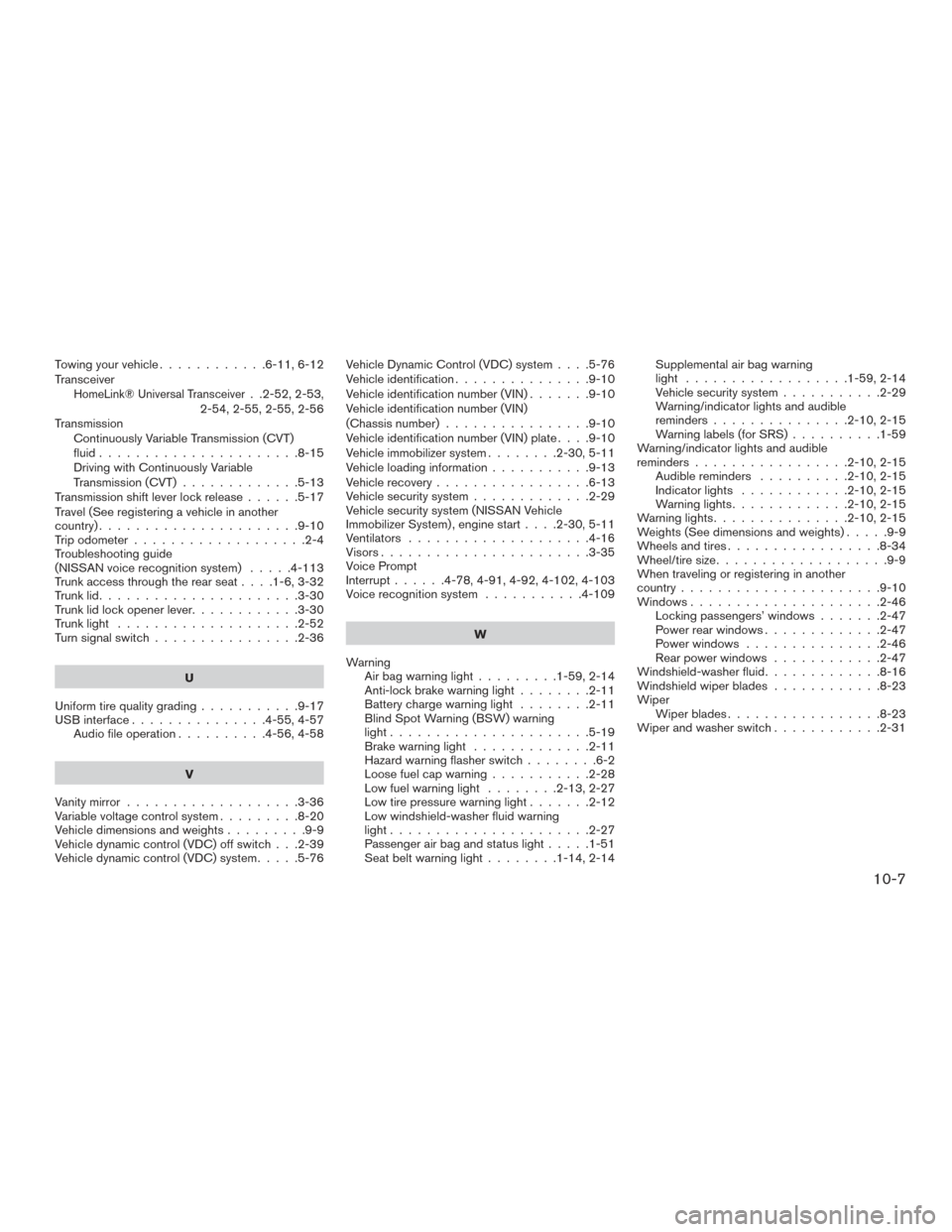
Towingyourvehicle............6-11,6-12
Transceiver
HomeLink® Universal Transceiver. .2-52, 2-53,
2-54, 2-55, 2-55, 2-56
Transmission Continuously Variable Transmission (CVT)
fluid......................8-15
Driving with Continuously Variable
Transmission (CVT) .............5-13
Transmission shift lever lock release ......5-17
Travel (See registering a vehicle in another
country) ......................9-10
Trip odometer ...................2-4
Troubleshooting guide
(NISSAN voice recognition system) .....4-113
Trunk access through the rear seat ....1-6,3-32
Trunklid......................3-30
Trunk lid lock opener lever ............3-30
Trunklight ....................2-52
Turn signal switch ................2-36
U
Uniform tire quality grading ...........9-17
USB interface ...............4-55,4-57
Audio file operation ..........4-56,4-58
V
Vanity mirror ...................3-36
Variable voltage control system .........8-20
Vehicledimensionsandweights.........9-9
Vehicle dynamic control (VDC) off switch . . .2-39
Vehicle dynamic control (VDC) system .....5-76Vehicle Dynamic Control (VDC) system
....5-76
Vehicle identification ...............9-10
Vehicle identification number (VIN) .......9-10
Vehicle identification number (VIN)
(Chassis number) ................9-10
Vehicle identification number (VIN) plate ....9-10
Vehicle immobilizer system ........2-30,5-11
Vehicle loading information ...........9-13
Vehicle recovery .................6-13
Vehicle security system .............2-29
Vehicle security system (NISSAN Vehicle
Immobilizer System) , engine start ....2-30,5-11
Ventilators ....................4-16
Visors.......................3-35
Voice Prompt
Interrupt......4-78,4-91,4-92,4- 102, 4-103
Voice recognition system ...........4-109
W
Warning Airbagwarninglight.........1-59,2-14
Anti-lock brake warning light ........2-11
Battery charge warning light ........2-11
Blind Spot Warning (BSW) warning
light......................5-19
Brake warning light .............2-11
Hazard warning flasher switch ........6-2
Loose fuel cap warning ...........2-28
Lowfuelwarninglight ........2-13,2-27
Low tire pressure warning light .......2-12
Low windshield-washer fluid warning
light......................2-27
Passenger air bag and status light .....1-51
Seatbeltwarninglight........1-14,2-14 Supplemental air bag warning
light ..................1-59,2-14
Vehicle security system
...........2-29
Warning/indicator lights and audible
reminders ...............2-10,2-15
Warning labels (for SRS) ..........1-59
Warning/indicator lights and audible
reminders.................2-10,2-15 Audiblereminders ..........2-10,2-15
Indicatorlights ............2-10,2-15
Warning lights .............2-10,2-15
Warning lights ...............2-10,2-15
Weights (See dimensions and weights) .....9-9
Wheels and tires .................8-34
Wheel/tire size ...................9-9
When traveling or registering in another
country ......................9-10
Windows .....................2-46
Locking passengers’ windows .......2-47
P
ower rear windows .............2-47
Power windows ...............2-46
Rear power windows ............2-47
Windshield-washerfluid.............8-16
Windshieldwiperblades............8-23
Wiper Wiperblades.................8-23
Wiper and washer switch ............2-31
10-7